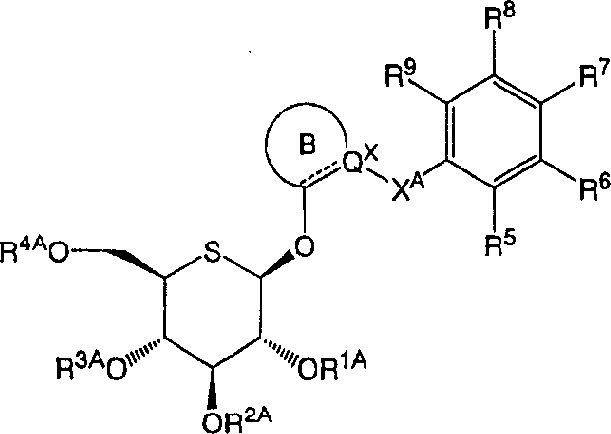Heteroaryl 5-thio-beta-d-glucopyranoside derivatives and remedies for diabetes containing the same
A glucopyranoside and thiol technology, applied in the field of pharmaceuticals and heteroaryl 5-thio-β-D-glucopyranoside compounds, can solve the problem of not involving SGLT inhibition and no β-selective glucopyranoside. Glycosylation chemical synthesis method, does not involve problems such as heteroaryl 5-thio-β-D-glucopyranoside derivatives
- Summary
- Abstract
- Description
- Claims
- Application Information
AI Technical Summary
Problems solved by technology
Method used
Image
Examples
preparation example Construction
[0149] The production method of the compound of the present invention is explained below.
[0150] You can use the following process to use PR X R Y R Z Phosphines represented by R 21 -N=N-R 22 Under the conditions of Mitsunobu reaction (Org.Reactions, volume 42, item 335) of the azo reagent represented, make the 5-thio-D-glucopyranoside compound of formula (IV) and the heteroaryl compound of formula (VI) Alcohol reaction to prepare heteroaryl 5-thio-β-D-glucopyranoside compounds.
[0151]
[0152] In addition, the compound of the present invention can be prepared by deprotecting a protecting group such as a sugar hydroxyl group or prodrugizing as necessary.
[0153] "Heteroaryl alcohol" means a compound in which an OH group is substituted on a heteroaryl group, and includes the keto form of a keto-enol tautomer.
[0154] "PR X R Y R Z Indicated phosphines", R X ~R Z Can be the same or different, means can be C 1-6 Alkyl-substituted phenyl (e.g. phenyl, tolyl), ...
reference example 1
[0317] Preparation of 4-(4-ethylbenzyl)-3-hydroxy-1-isopropyl-5-methyl-1H-pyrazole
[0318] In 1,2-dihydro-4-(4-ethylbenzyl)-5-methyl-3H-pyrazol-3-one (synthesized according to WO0116147; 1.0g, 4.6mmol), benzyl alcohol (600mg , 5.5 mmol) and triphenylphosphine (1.46 g, 5.5 mmol) in tetrahydrofuran (30 mL), diethyl azodicarboxylate (40% toluene solution, 5.1 mmol) was added dropwise under ice-cooling. After stirring overnight at room temperature, the residue obtained by concentrating the reaction solution was purified by silica gel column chromatography (hexane: ethyl acetate = 75:25 to 70:30) to obtain 3-benzyloxy-4- (4-Ethylbenzyl)-5-methyl-1H-pyrazole (550 mg, 39%).
[0319] 1 H-NMR (300MHz, CDCl 3 ): δ1.21(t, J=7.6Hz, 3H), 2.11(s, 3H), 2.60(q, J=7.6Hz, 2H), 3.66(s, 2H), 5.24(s, 2H), 7.03 -7.15(m, 4H).
[0320] ESI m / z=307(M+H).
[0321] mp 80.0-83.0℃.
[0322] At room temperature, in the above obtained 3-benzyloxy-4-(4-ethylbenzyl)-5-methyl-1H-pyrazole (200mg, 0.65mm...
reference example 2
[0330] Preparation of 1-acetyl-4-[(3-fluoro-4-methoxyphenyl)methyl]-3-hydroxy-5-methyl-1H-pyrazole
[0331] 1,2-dihydro-4-[(3-fluoro-4-methoxyphenyl)methyl]-5-methyl-3H-pyrazol-3-one (synthesized according to WO0236602; 4.11g, A mixture of 0.0174 mol), acetic anhydride (41 mL) and acetic acid (41 mL) was stirred at 135°C for 8 hours and at room temperature for 12 hours. After concentrating the reaction liquid, toluene was added and concentrated again. Methanol (400 mL) and 25 wt % sodium methoxide methanol solution (0.37 mL) were added to the obtained residue, followed by stirring for 20 hours. The residue obtained by concentrating the reaction solution was purified by silica gel column chromatography (hexane: ethyl acetate = 4:1 to 1:1) to obtain 1-acetyl-4-[(3-fluoro-4-methanol) as a colorless powder Oxyphenyl)methyl]-3-hydroxy-5-methyl-1H-pyrazole (960 mg, 20%).
[0332] 1 H-NMR (300MHz, CDCl 3 ): δ2.50(s, 3H), 2.51(s, 3H), 3.61(s, 2H), 3.85(s, 3H), 6.80-6.99(m, 3H). ...
PUM
 Login to View More
Login to View More Abstract
Description
Claims
Application Information
 Login to View More
Login to View More - R&D
- Intellectual Property
- Life Sciences
- Materials
- Tech Scout
- Unparalleled Data Quality
- Higher Quality Content
- 60% Fewer Hallucinations
Browse by: Latest US Patents, China's latest patents, Technical Efficacy Thesaurus, Application Domain, Technology Topic, Popular Technical Reports.
© 2025 PatSnap. All rights reserved.Legal|Privacy policy|Modern Slavery Act Transparency Statement|Sitemap|About US| Contact US: help@patsnap.com



